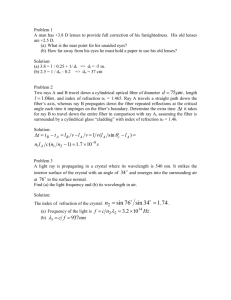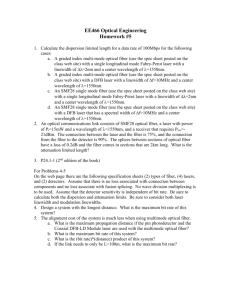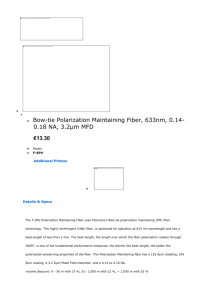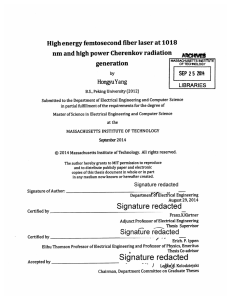Solution 5
advertisement
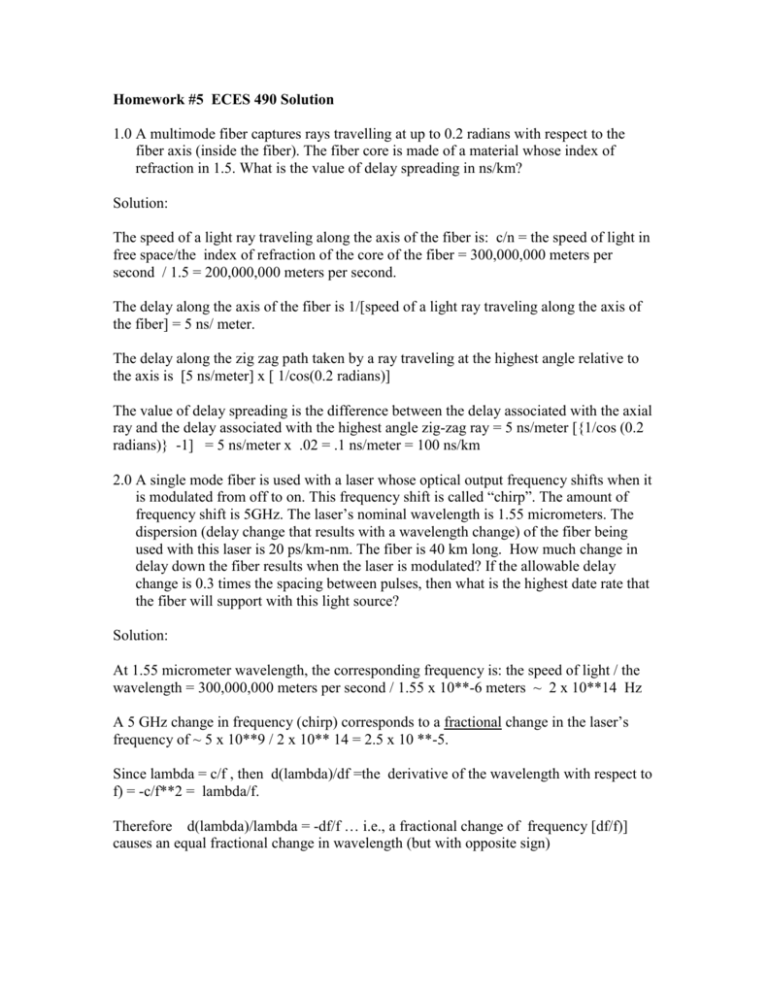
Homework #5 ECES 490 Solution
1.0 A multimode fiber captures rays travelling at up to 0.2 radians with respect to the
fiber axis (inside the fiber). The fiber core is made of a material whose index of
refraction in 1.5. What is the value of delay spreading in ns/km?
Solution:
The speed of a light ray traveling along the axis of the fiber is: c/n = the speed of light in
free space/the index of refraction of the core of the fiber = 300,000,000 meters per
second / 1.5 = 200,000,000 meters per second.
The delay along the axis of the fiber is 1/[speed of a light ray traveling along the axis of
the fiber] = 5 ns/ meter.
The delay along the zig zag path taken by a ray traveling at the highest angle relative to
the axis is [5 ns/meter] x [ 1/cos(0.2 radians)]
The value of delay spreading is the difference between the delay associated with the axial
ray and the delay associated with the highest angle zig-zag ray = 5 ns/meter [{1/cos (0.2
radians)} -1] = 5 ns/meter x .02 = .1 ns/meter = 100 ns/km
2.0 A single mode fiber is used with a laser whose optical output frequency shifts when it
is modulated from off to on. This frequency shift is called “chirp”. The amount of
frequency shift is 5GHz. The laser’s nominal wavelength is 1.55 micrometers. The
dispersion (delay change that results with a wavelength change) of the fiber being
used with this laser is 20 ps/km-nm. The fiber is 40 km long. How much change in
delay down the fiber results when the laser is modulated? If the allowable delay
change is 0.3 times the spacing between pulses, then what is the highest date rate that
the fiber will support with this light source?
Solution:
At 1.55 micrometer wavelength, the corresponding frequency is: the speed of light / the
wavelength = 300,000,000 meters per second / 1.55 x 10**-6 meters ~ 2 x 10**14 Hz
A 5 GHz change in frequency (chirp) corresponds to a fractional change in the laser’s
frequency of ~ 5 x 10**9 / 2 x 10** 14 = 2.5 x 10 **-5.
Since lambda = c/f , then d(lambda)/df =the derivative of the wavelength with respect to
f) = -c/f**2 = lambda/f.
Therefore d(lambda)/lambda = -df/f … i.e., a fractional change of frequency [df/f)]
causes an equal fractional change in wavelength (but with opposite sign)
Thus the wavelength change, during modulation from on to off, is ~ 1.55 micrometers x
2.5 x 10**-5 ~ .04 nanometers.
The change in delay that is associated with this change in wavelength is .04 nm x 20
ps/km-nm =0.8 ps/km. In 40 km, the delay change is 0.8 ps/km x 40 km = 32 ps
If 32 ps must be less than 0.3 x the pulse spacing, then the pulse spacing must be greater
than ~ 100 ps.
If the pulse spacing must be greater than 100 ps, then the date rate must be less than
1/100ps = 10 Gbps.
3.0 A fiber optic system receiver has a minimum required energy per pulse of 12,000
photons per pulse. The photon energy at the optical wavelength of interest is 1.5 x
10**-19 J. The optical transmitter in this system is a laser with a peak output power
of 1.0 mW. The coupling loss from the laser into the fiber is 1.5 dB. The fiber loss is
0.4 dB/km, including splices. Assuming that we want to allow 5 dB of system margin
(actual received signal level vs. minimum allowable received signal level), what is the
maximum allowable fiber length between the transmitter and the receiver at a data
rate of 10 Gbps.
Solution:
The required energy per received pulse is: 12,000 photons per pulse x 1.5 x 10**-19
J/photon = 1.8 x 10**-15 J/pulse.
At a data rate of 10 Gbps, the average power required at the receiver is: 1.8 x 10**-15
J/pulse x 10**10 pulses per second x 0.5 (half of the pulses are on, half of the pulses are
off) = 9 x 10**-6 Watts = 9 microWatts.
The peak power output of the laser is 1 mW = 1000 microWatts. The average laser power
output (if it is on half of the time) is 500 microWatts
The total link loss budget is: [500 microWatt / 9 microWatt] ~55.5 ~ 17.4 dB
Allowing 5 dB for margin, and 1.5 dB for laser-to-fiber coupling loss, there is:
17.4 dB – 5 dB – 1.5 dB = 10.9 dB of link loss budget available for fiber loss.
Thus the maximum allowable fiber length is 10.9 dB / 0.4 dB per kilometer ~27 km.


